Mold Toxicity: The Effects of Living with Mold
Rapid growth and an overtaking of your environment are a few characteristics that can be used to describe the dreaded but common household issue that we know as mold. Mold is a fungus that can grow on almost anything, with the ability to thrive in many conditions but most specifically in warm temperatures and high moisture environments.
The versatility of mold allows for this fungus to grow in both indoor and outdoor environments, making it an invasive presence in both your outdoor area and most importantly in your indoor areas such as your home. When you are exposed to mold chronically, you can develop mold toxicity symptoms.
Mold can spread far and wide, as tiny, microscopic spores called mycotoxins, are released from the source to allow additional mold to grow. As mold begins to reproduce, its effect on humans who have been exposed could be significant.
Sensitivities can plague some individuals when contact occurs between mold, with symptoms spurring into overdrive in some cases. The type of mold present can lead to variations of symptoms, with a rough estimate of 1,000 species of mold currently in the United States (1). The level of hazard existing to human health can significantly reflect based upon the specific type of mold in the environment and can thus lead to a scary health effect called mold toxicity.
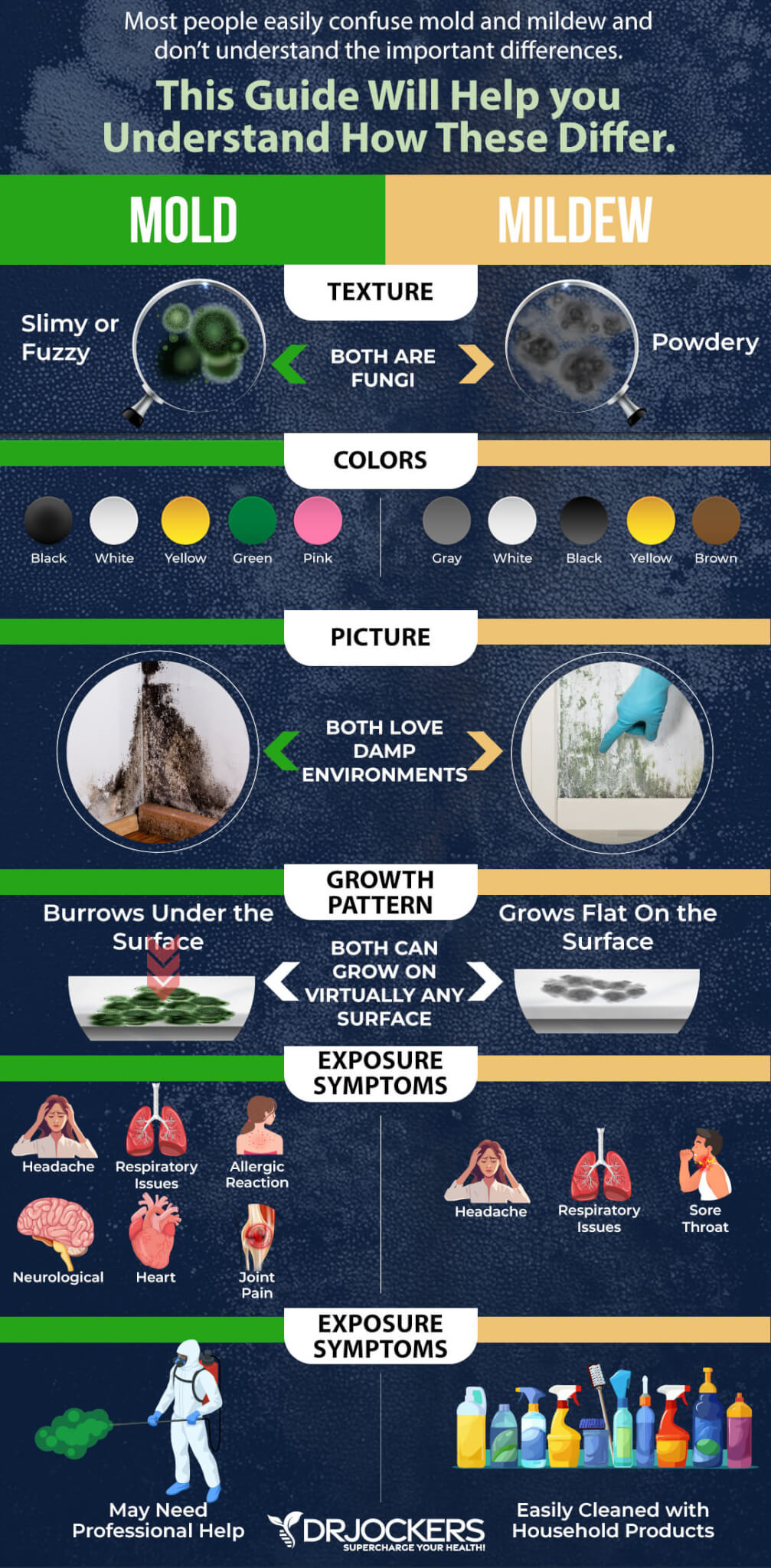
What is Mold Toxicity?
Mold toxicity occurs when mycotoxins are produced by micro-fungi such as mold, that can affect your body’s system leading to chronic symptoms.
It is estimated that 24% of the population is genetically susceptible to this illness and will begin experiencing chronic inflammatory immune responses as a result of this exposure. Toxins produced by mold will start to accumulate inside the body and trigger inflammatory reactions that cause a wide variety of symptoms from allergies, sinus congestion, and breathing issues to fatigue, brain fog, and mood disorders such as depression and anxiety.

Mold Toxicity vs Mold Allergies
Often times confusion surrounds the different mold illnesses, specifically mold toxicity and mold allergies. These two separate illnesses illicit different reactions in the body and can affect a person differently.
Mold allergies are caused by mold spores that become inhaled and stimulate symptoms similar to those of hay fever (2). Mold toxicity, in comparison to mold allergies, is caused by the volatile toxic vapors that are dispersed by mold which in turn elicits a chronic inflammatory response.
Diagnosing this condition is very hard, especially for medical professionals who often misdiagnose it because of the wide variation of possible symptoms. The first step in diagnosing mold toxicity or even mold allergies is identifying mold within your environment, particularly in your home.
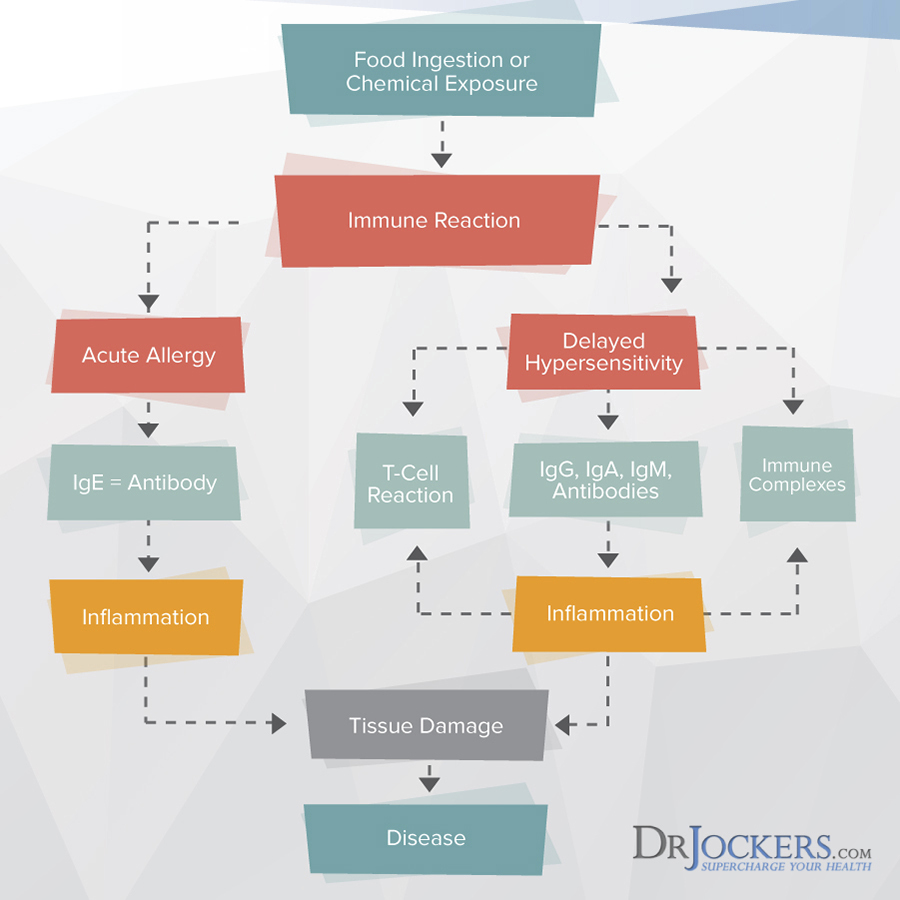
How to Check for Mold in a House
If you suspect a mold source in your home the first thing you will want to do is test/check for mold in your environment. Even if you do not suspect mold inside your home, you should still do a simple test to ensure mold growth is not occurring in your home, particularly if you are experiencing unexplainable symptoms.
Mold toxicity can be a devious stealer of health. When checking for mold growth you should look for these three characteristics: mold growth, moisture/water leaks, and health symptoms.
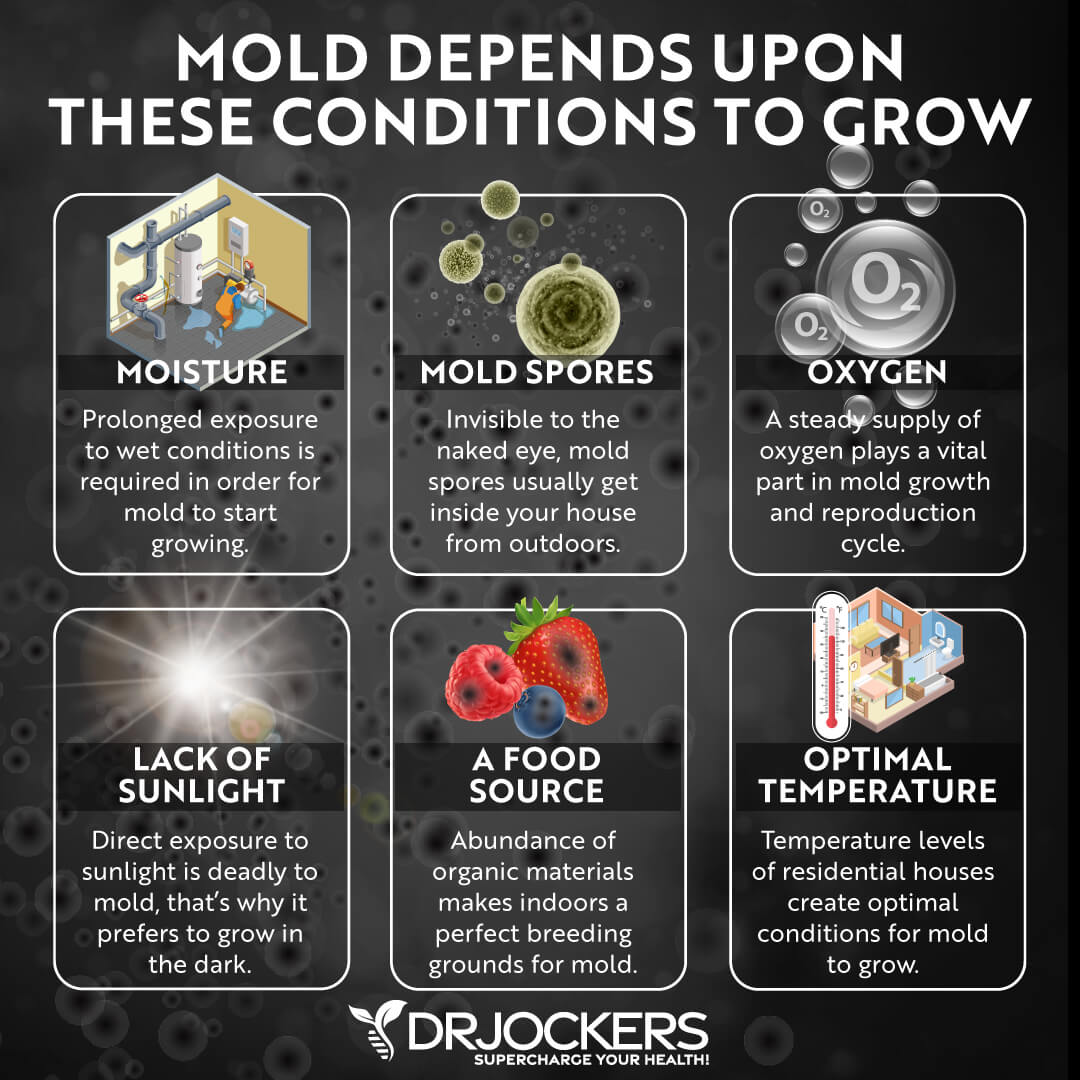
Mold Growth
Most mold is unmistakable, but sometimes hidden growths can appear as just surface dirt on your wall, ceiling, etc. If you see any new discolorations to your home’s surface, immediate action needs to be implemented. However, the scary reality is that the dangerous molds that grow in your home are often the molds that you cannot visibly see!
In addition to certain species of mold being hard to see, mold can grow in areas of the house that don’t get looked at very often. Once mold has spread into the air, you can build mold toxicity in the body without ever knowing it was in your house.
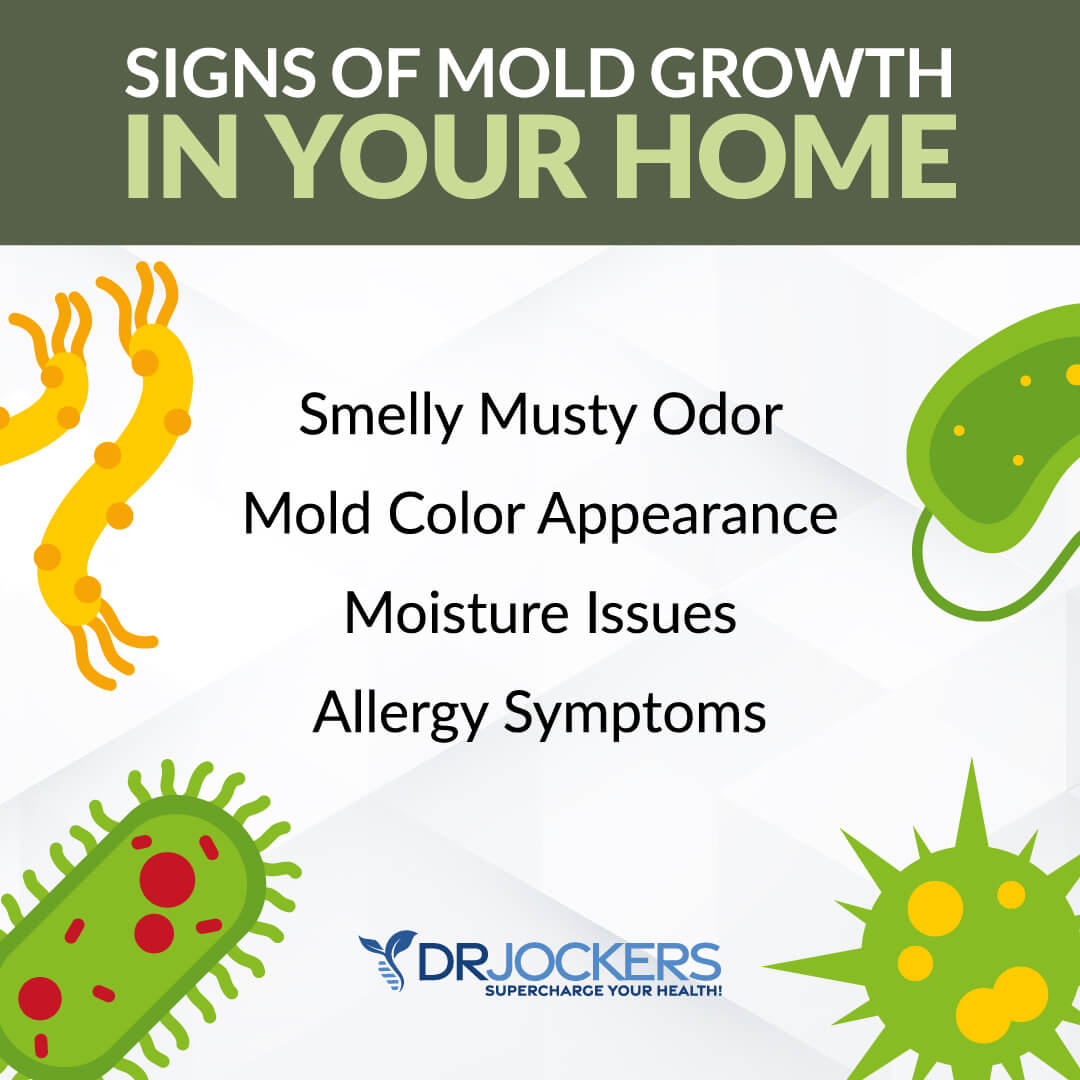
Moisture/Water Leaks
Anywhere in your home where moisture is present can produce mold. Moisture and warm environments are desirable conditions in which mold is happy to make a home and reproduce (3).
Therefore, any area in your home where there is a lot of moisture such as in a bathroom, laundry room, or kitchen can potentially be exposed to mold growth.
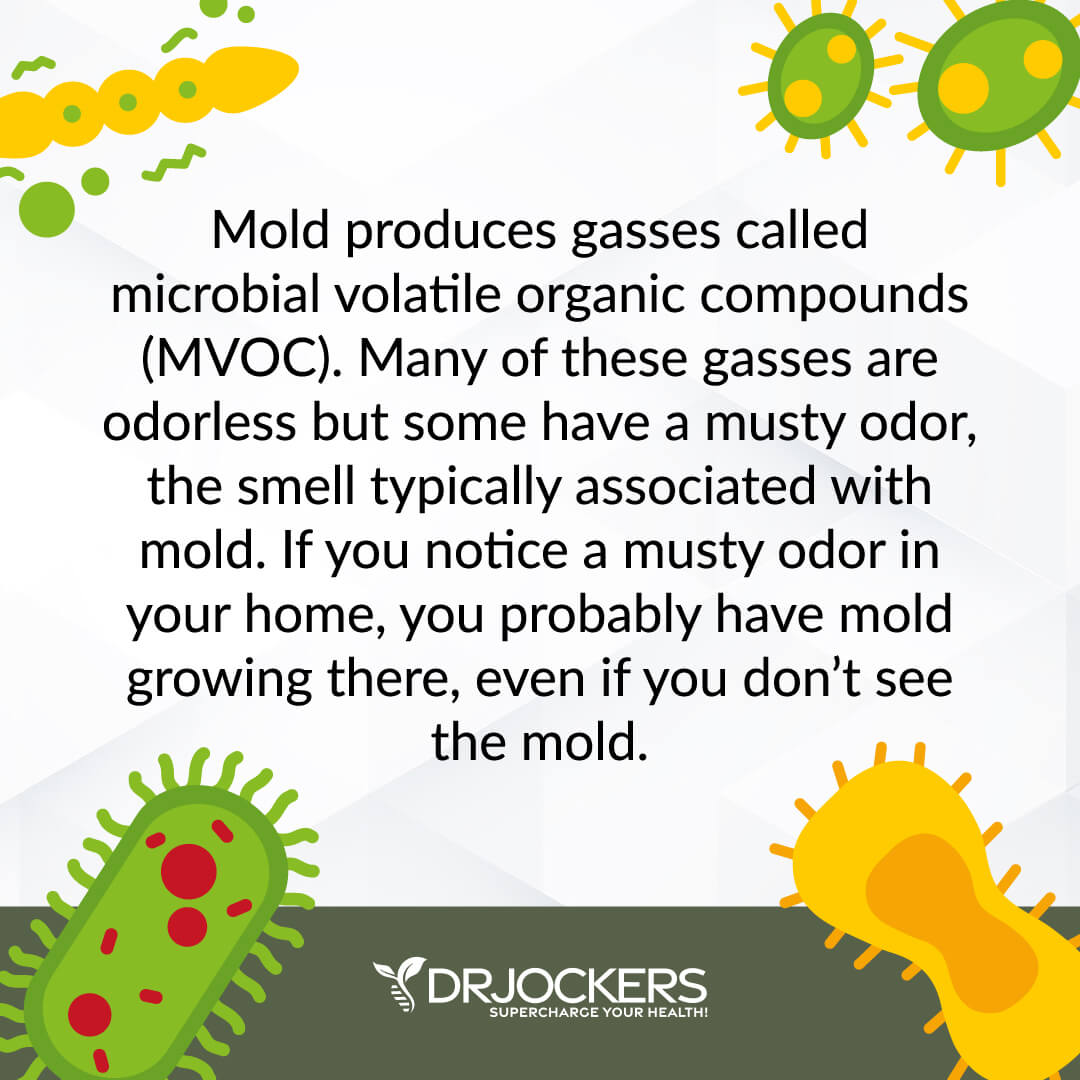
Health Symptoms
Mold exposure in indoor environments can lead to an array of potential health issues and symptoms (4). During the reproduction process of mold, mold spores, and mycotoxins are released into the air and can become inhaled through the nose and mouth. Once mold spores enter into your body, it can trigger a plethora of symptoms.
Health symptoms of mold toxicity include the following:
- Respiratory problems
- Skin inflammation
- Hemorrhage
- Mucus membrane irritation
- Mental impairment
- Fatigue
- Nausea
Household Molds That Can Lurk Inside Your Home
Mold is, unfortunately, pretty much unavoidable in your home as most homes harbor some species of mold in their confines. Out of the 1,000s mold species, there are some species that are more prone to growth indoors than others and some that particularly grow inside homes.
There are six main species of mold that are commonly found inside homes, and each contains its own characteristics and potential health hazards.
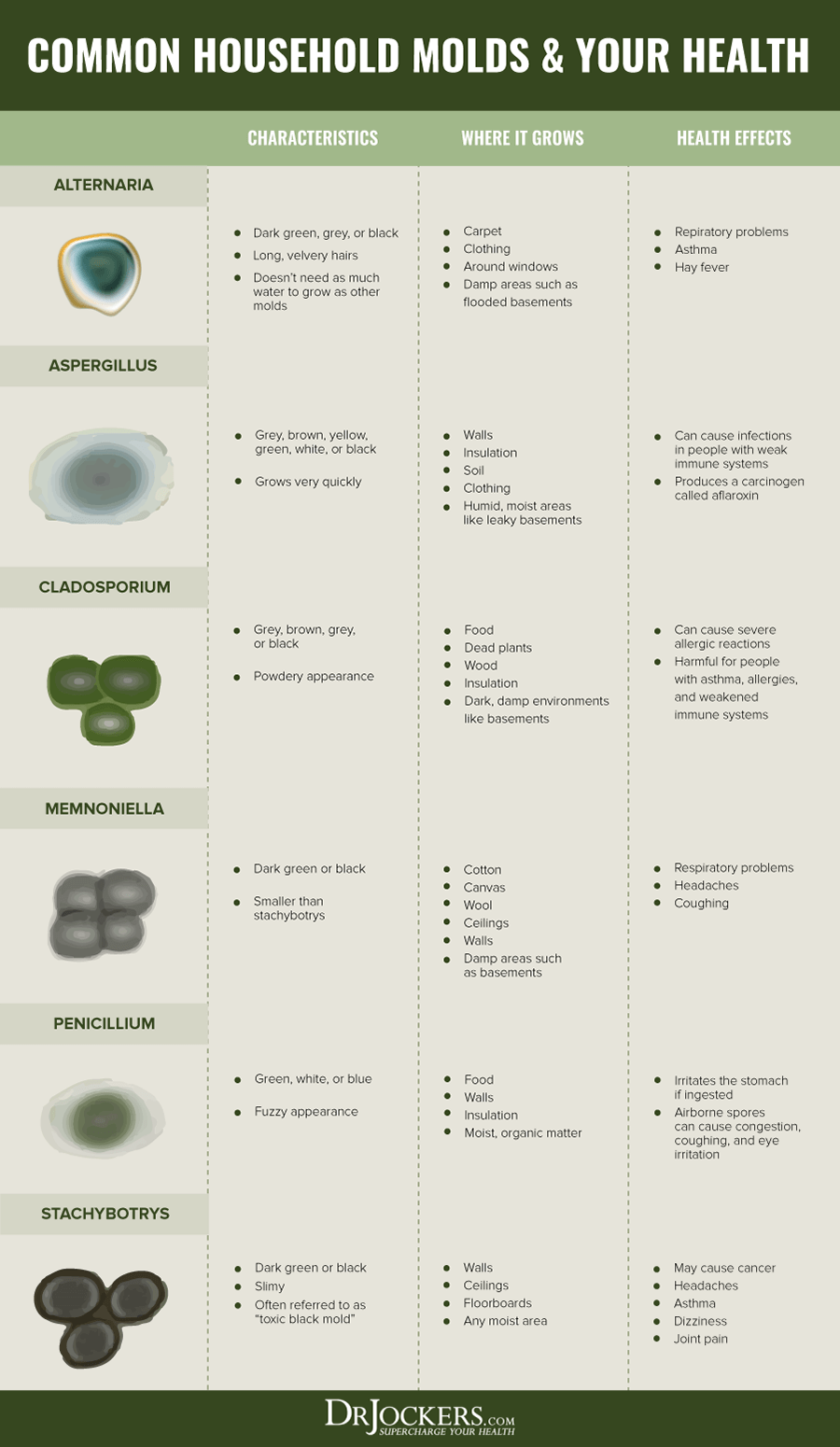
Alternaria
A known allergy causing fungus, Alternaria has been shown to affect 70% of mold allergy patients that react to this species of mold during a skin test. Exacerbated asthma symptoms for both rhinitis and bronchial asthma are significantly impacted by the airborne spores released from this household mold. Alternaria has a high presence during the spring “allergy season” and throughout till late fall.
Alternaria is a common outdoor mold whose main habitats include plants, trees, grasses, and soil, and is directed by the wind inside your home or travels on people’s clothing and shoes. Identifying Alternaria in your home starts with increased allergy and asthma symptoms and noticeable discoloration of either green, black, or grayish color.
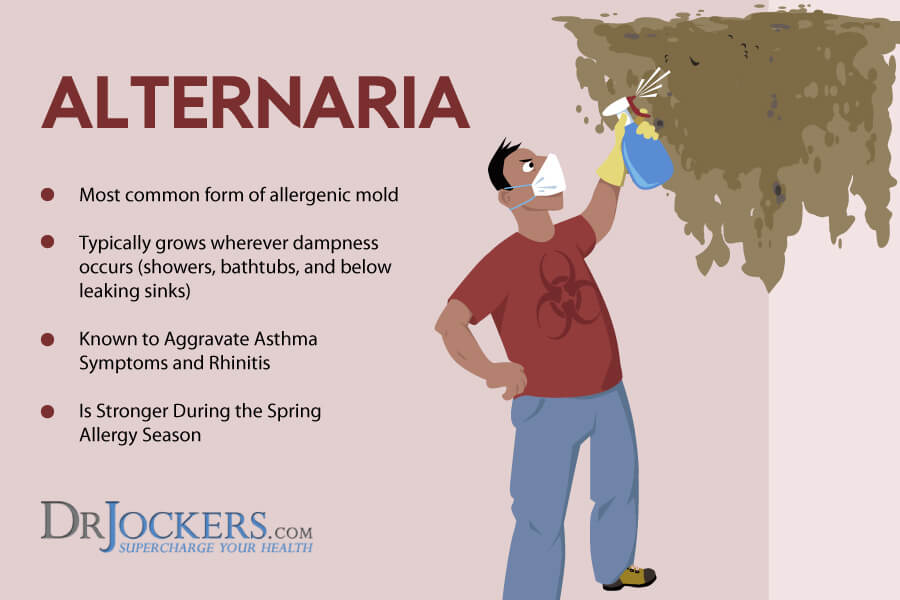
Aspergillus
The indoor household mold, aspergillus is a mold that is known for producing hydrophobic spores that are easily inhaled due to their extremely small size. When these small spores are inhaled a condition called Aspergillosis can develop which will cause an immune response in the body that can bring symptoms such as a fever, asthma attacks, and coughing up mucus or even blood. Aspergillus is attracted to dust and therefore lures the mold into households, especially ones with a buildup of dust.
The appearance of aspergillus is typically a variety of colors including grey, brown, yellow, green, white, or even black. Once this mold forms it will rapidly grow, particularly on walls, insulation, clothing, and any humid moist area.
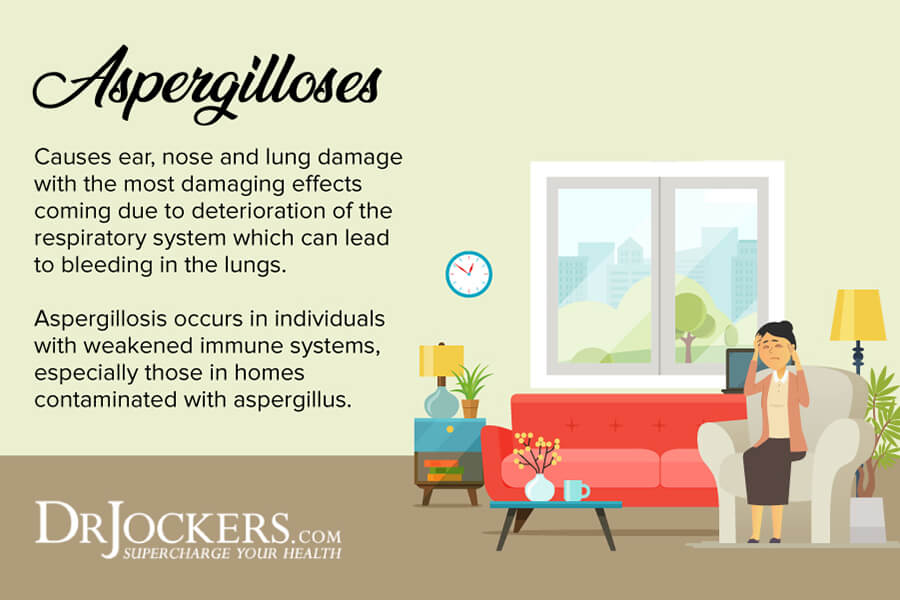
Cladosporium
A common household mold, Cladosporium is a versatile mold species that has the ability to grow in both warm and cool environments. Identifying this type of mold can be challenging, as there are over 500 species of Cladosporium – the help of a mold professional may be required to identify this mold. Severe allergic reactions can be triggered in the presence of this mold, as it can be harmful to people with asthma, allergies, and weakened immune systems when they are exposed to the mold in their environment.
Cladosporium is typically found on food, dead plants, wood, insulation, and dark damp environments like a basement. If you start to experience severe respiratory symptoms, check these areas for discolorations of grey, brown, or black on the surfaces of these environments.
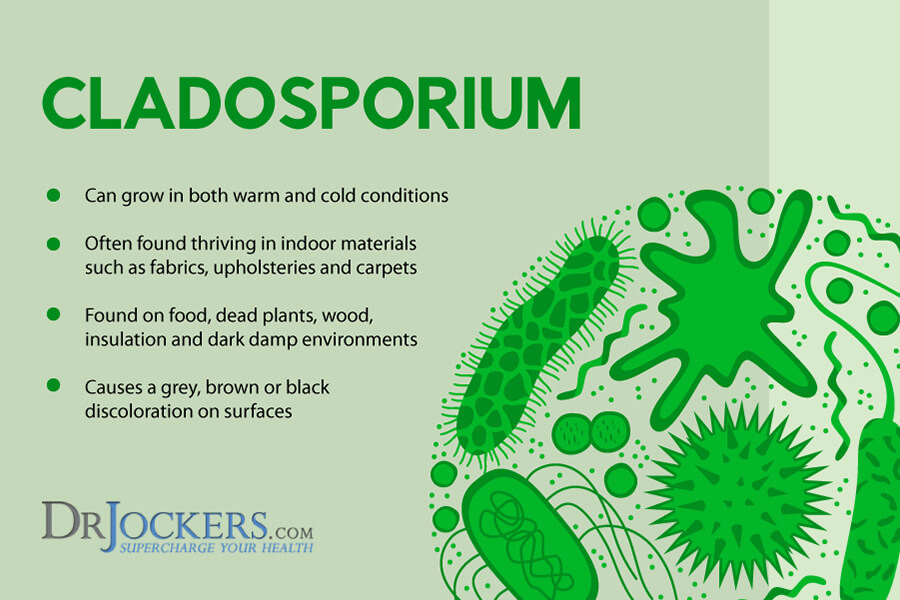
Memnoniella
Do you have the dreaded black mold growing in your home? Memnoniella mold is often associated with the toxic Stachybotrys mold that every homeowner hopes to never have to deal with. Unfortunately, however, if you see memnoniella growing then stachybotrys is likely to be found in the air as well.
This mold produces the same type of allergic symptoms in humans as the toxic black mold, but in comparison, memnoniella is smaller and can therefore penetrate the lining of the lungs easier than black mold and cause respiratory problems, headaches, and coughing upon exposure.
Memnoniella can usually be found growing on cotton, canvas, wool, ceilings, walls, and damp areas like basements and bathrooms. This molds a dark appearance with green and black coloration making it easy to identify in your home.
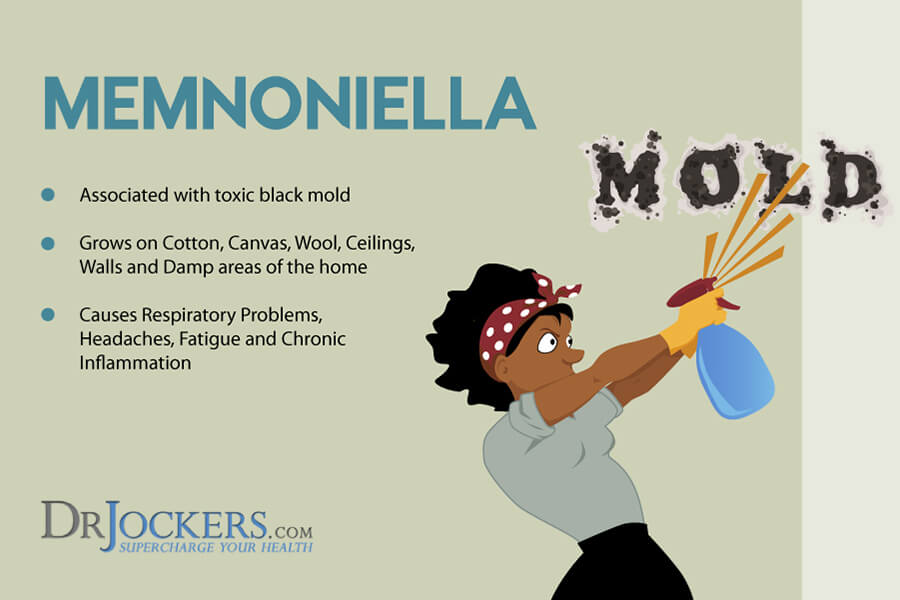
Stachybotrys
Stachybotrys, aka toxic black mold, is a hazardous species of mold that can be found in indoor environments that provide the ideal conditions; moisture, nutrient source, and warm temperature. The name black mold originated from its slimy dark appearance (black or dark green) that forms on the surfaces of your home. Black mold can be found in any moist area, particularly on walls, ceilings, and floorboards.
This toxic mold produces toxic compounds called mycotoxins that can cause significant health problems when people are exposed to them including headaches, asthma, dizziness, joint pain, and in extreme cases can lead to cancer.

Penicillium
Where water damage has occurred, you can typically suspect penicillium mold to be growing in this environment usually on carpeting, wallpaper, insulation, and furnishings. Penicillium rapidly grows throughout the environment and appears as a green, white, or blue discoloration on exposed surfaces.
Penicillium can significantly irritate the stomach if ingested and when the mold creates airborne mold spores in your environment it can lead to congestion, coughing, and eye irritation.
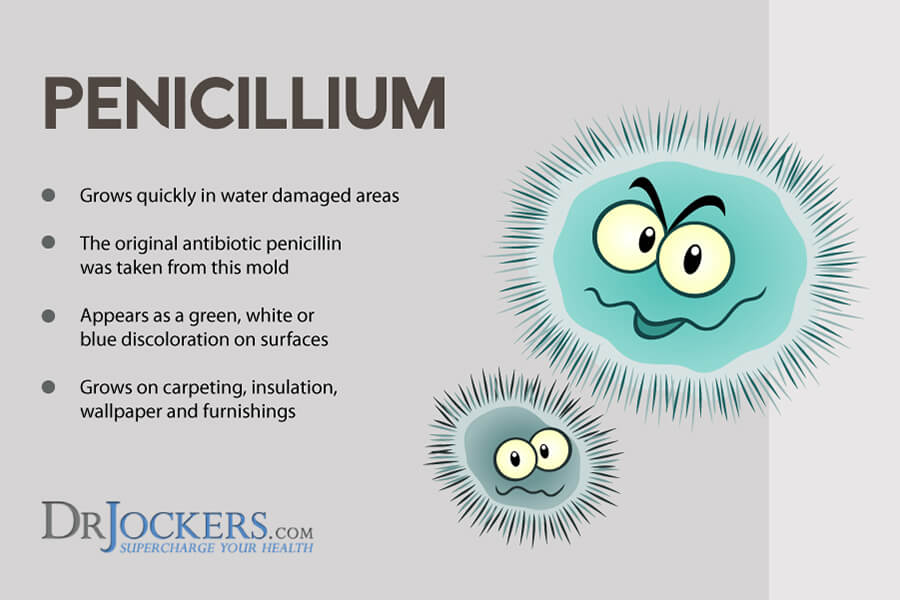
Plan of Attack to Removing Mold from Your Home
What can you do when you find a mold source in your home? What plan of action is required next? First and foremost, when you locate mold growth in your home you will want to examine the underlying cause of the mold growth, whether there was a moisture leak or what type of conditions surround the mold in the environment.
Second, you will want to call a mold remediation specialist to assist you in the removal of this mold from your home’s surfaces. Often times we will try to utilize different methods of mold removal that we find online, but in reality, the best solution is to have a trained professional come to your aid to ensure that proper removal occurs of this mold.
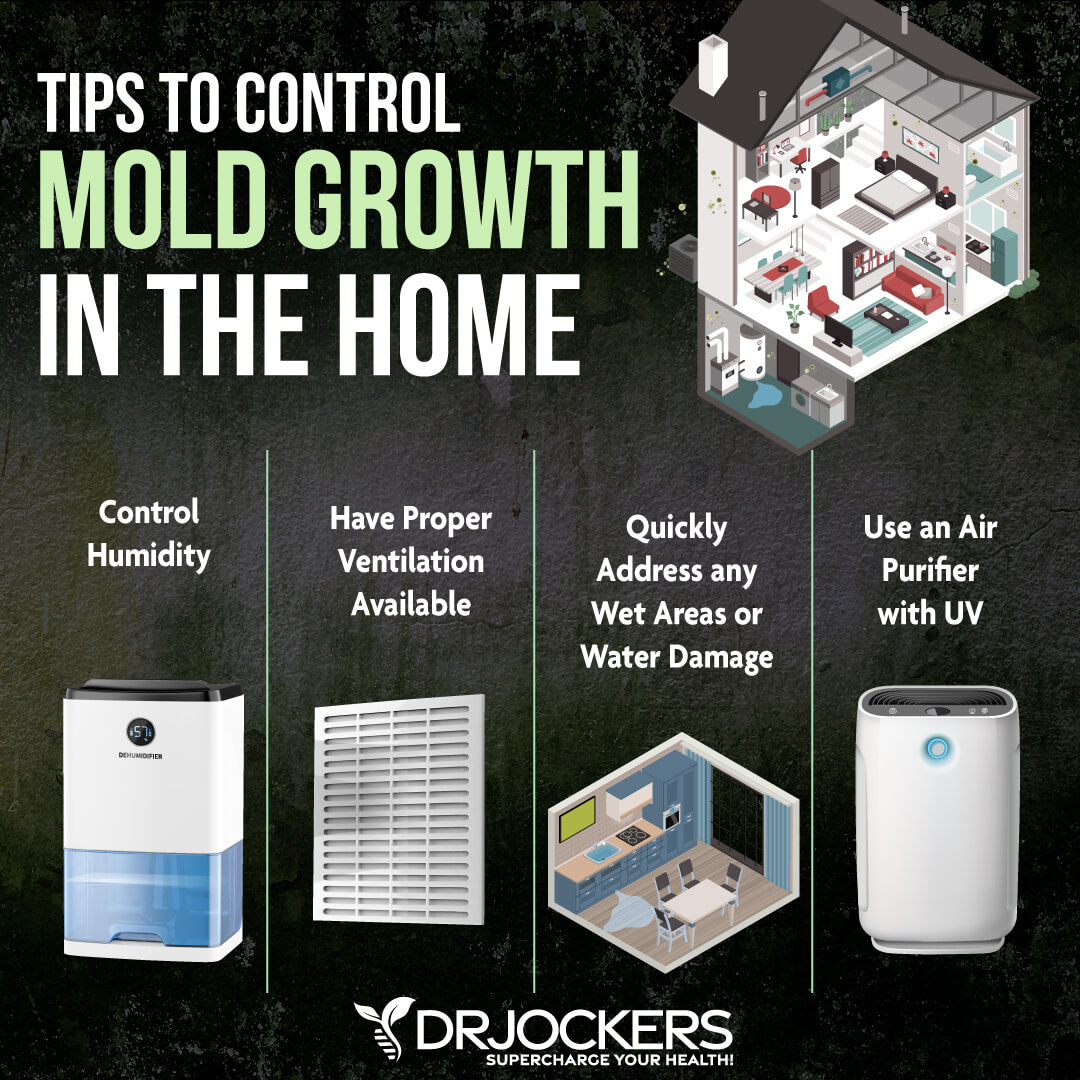
Third, eliminate the mold spores that have traveled into your air. We often don’t consider that mold can compromise the quality of your home’s air by collecting mold spores released from the mold.
How can you eliminate these mold spores from your air? The enhanced chemical reactivity found in the EnviroKlenz Cartridge makes it ideal for removing harmful mold-generated VOCs.
The EnviroKlenz Mobile UV Air System is a portable air filtration machine that contains this enhanced chemically reactive technology that can effectively work at taking in mold spores and capturing them from your air.
This UV system has the ability to completely destroy microorganisms such as mold spores that are in your air, by utilizing UVC (ultraviolet germicidal radiation) lights that shine upon the collected spores on top of the hospital-grade HEPA filter. With VOC elimination, particulate removal, and the ability to kill mold spores, this air purification system is the ideal purifier for any type of mold in your home.
Testing for Mold Toxicity
If you find mold in your home or workplace, it is important to test for mold toxicity in your body. Oftentimes, people who are struggling to get healthy (even when they seem to be doing everything right), are dealing with mold toxicity.
Mold toxins increase the burden on the liver and create chronic inflammation in the body. These toxins are highly indicated in neurological disorders and symptoms like brain fog, depression, and anxiety. One very effective option for testing mold toxins in the body is the GPL-MycoTOX Profile.
Addressing Mold Toxicity in the Body
If you find elevated mold toxins in the body, you will want to take measures to improve detoxification systems. In addition to this, you will want to ensure the source of mold is remediated properly. Using an air purification system like The EnviroKlenz Mobile UV Air System is the last step in a comprehensive mold mitigation protocol.
When it comes to getting mold toxins out of the body, the following is my go-to stack:
ThyroLiver Protect: A combination of selenium, milk thistle extract, Alpha-Lipoic Acid, and N-Acetyl-L-Cysteine. This combination assists liver detoxification while supporting the production of glutathione. Taking 1–2 caps, 2 times daily helps your liver neutralize and process the mold spores.
Super Glutathione: For tough cases, extra glutathione can be necessary. This is an acetylated form that is able to be absorbed by the digestive tract. I recommend 1–2 caps – 2 times daily. This is especially important if you are suffering with a lot of symptoms from mold exposure.
Activated Charcoal: When detoxification systems are upregulated, many toxins are released into the digestive tract. If they are not bound by something like charcoal, they are given the opportunity to reabsorb and cause more problems. Using 1–2 caps of charcoal between meals and immediately before bed is a great strategy.
BioToxin Binder: This product contains a special form of carbon that has a greater binding ability. It also contains wild-crafted yucca root and fulvic acid. It’s formulated specifically to support binding biotoxins like mold, ammonia, and aldehyde systemically. Take 1–2 caps – 2 times daily.
If you want to work with a functional health coach, I recommend this article with tips on how to find a great coach. Our website offers long-distance functional health coaching programs with our world-class team of health coaches. For further support with your health and other goals, just reach out—our fantastic coaches are here to support your journey.
Inflammation Crushing Ebundle
The Inflammation Crushing Ebundle is designed to help you improve your brain, liver, immune system and discover the healing strategies, foods and recipes to burn fat, reduce inflammation and Thrive in Life!
As a doctor of natural medicine, I have spent the past 20 years studying the best healing strategies and worked with hundreds of coaching clients, helping them overcome chronic health conditions and optimize their overall health.
In our Inflammation Crushing Ebundle, I have put together my very best strategies to reduce inflammation and optimize your healing potential. Take a look at what you will get inside these valuable guides below!
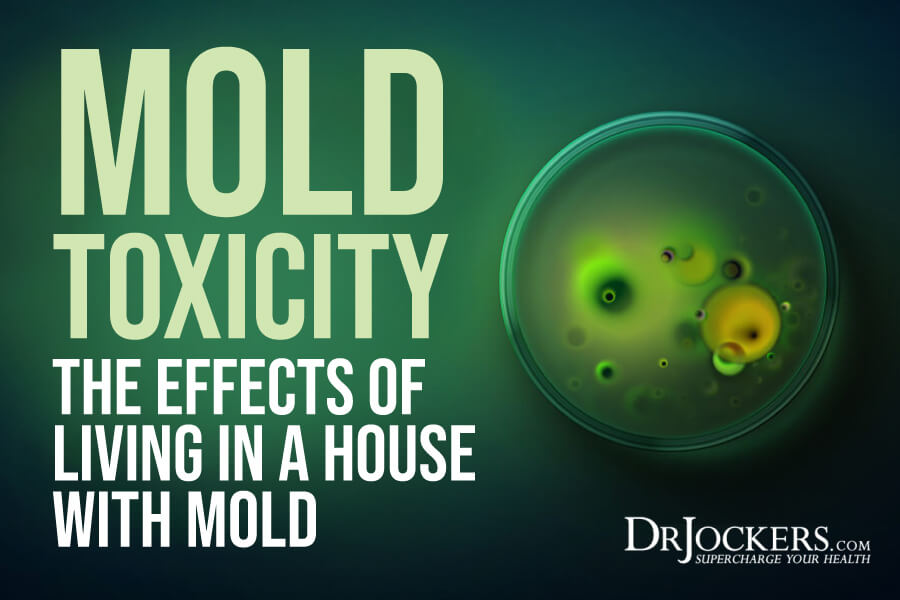



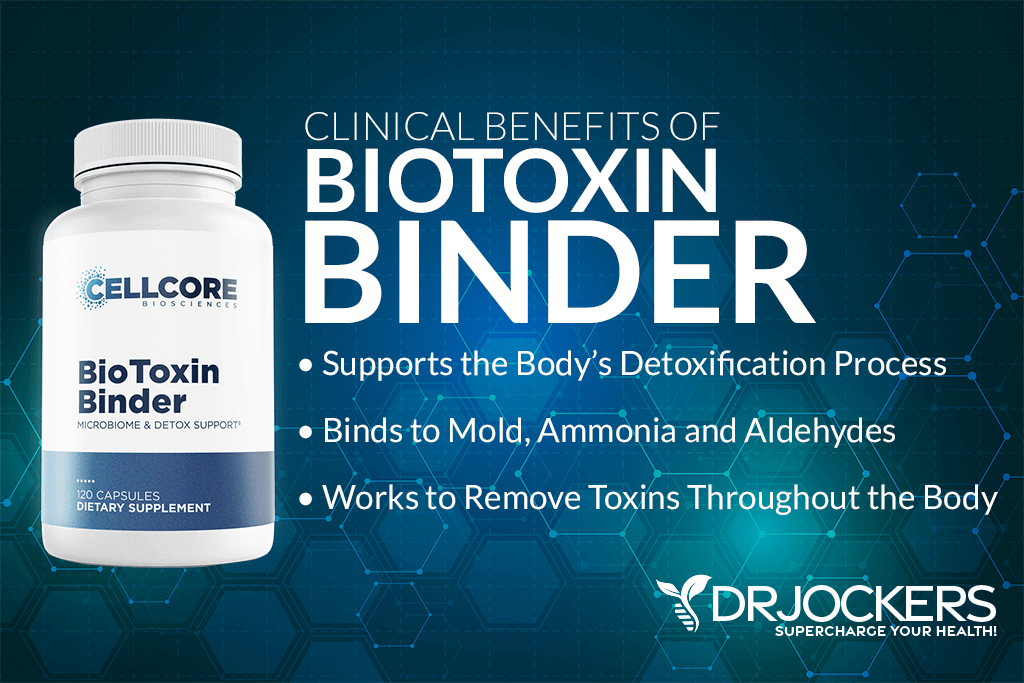





I see these comments are ~ a year old but in case someone has not found answers I wanted to respond. It is not likely you will find help from a mainstream medicine MD. I am a retired ICU nurse and have a good internist, but he was clueless about my symptoms. I wanted to have food sensitivity testing done which he would not order so finally the lab referred me to an integrative medicine MD who had ordered tests through them in the past. I took my most recent labwork and went to see this MD (90 miles from my house!), and had to pay him out of pocket. He immediately looked at my labwork and asked “Why is your CRP so high? Do you have a problem with mold at your house?”. We have had ductwork replaced in both our AC units (2 story house), and we have had both AC units replaced, within the past 4 years. We did have mold in the ductwork, which I thought was probably resolved. A few days after he asked me that question, I realized I had found some mold in our living room carpet a few weeks before the labwork. I had stored some boxes under the grand piano and apparently the carpet had been wet at some point-wet enough to allow mold to grow. I stupidly just reboxed the things that were affected and threw the moldy stuff away-not realizing that the contact I had could harm my health. This integrative medicine MD ordered a neurotransmitter test on me (paid for by medicare), which showed all my neurotransmitters were low except nor-epi and PEA, which were high. He ordered a mycotoxin test on me (done through Great Plains lab as described in this article) which showed very large positive to ochratoxin A and a large positive to micophenolic acid. We’re in the process of mold remediation now; our progress has been delayed by our homeowner’s insurance who delayed and obfuscated, changed claims adjusters twice, sent out an engineer, then after 8 weeks of this, denied our claims. This was not a case of having mold visible up the walls-the mold was in the carpet under some things, so was missed, but the adjacent walls appeared totally normal. I did learn through a webinar about a treatment for your home called BioBalance. I purchased this expensive kit and fogged my entire 2 story house with it. It comes with 4 petri dishes. We put petri dishes out before I fogged, then sent them in according to instructions. The pre-fogging cultures showed 3 different molds, one gray, one white, one black, all climbing over each other so you could not even see the agar in the bottom of the dish. It was disgusting. That culture showed the type of organisms, and that they were too numerous to count. Understand, the culture was done by simply sitting the dish on the affected carpet, and the spores grew so incredibly-which indicates to me that it is airborne, because none of the carpet touched the agar, it had to be an air-borne contamination. I’m sure that my contact with the moldy objects also introduced some of the toxins into my system, but with my history of respiratory allergeries, sinus infections, stuffiness at night, waking up every day with a headache, and severe insomnia, I know that I have been breathing in this stuff as well. The fact that I was under the care of several MDs of assorted board certifications and that they were oblivious to the cause of my issues, is alarming to me. In addition, I have paroxysmal atrial fib and my episodes had increased exponentially during this few months. Finally one day I googled “Do mycotoxins cause atrial fibrillation?” and found a cardiologist in Pheonix who has an entire website devoted to this topic.
I encourage you to read this material by Dr. Jockers here carefully, consider the testing even if you have to pay out of pocket (my mycotoxin test was out of pocket). I have spent a couple thousand $$ which I really could not afford, on the integrative medicine MD, supplements recommended, the Bio Balance kit, cultures. My initial info was from Evan Brand in a webinar about causes for insomnia! There is plenty of info out there on mold toxicity-you must educate yourself and look for answers because 90% of doctors today are just clueless. And though I say I could really not afford this, when you consider that both my mycotoxins are known carcinogens & ochratoxin A is also nephrotoxic, I could not afford to ignore the facts. Best wishes to you. First you must find an integrative medicine MD who will recognize the symptoms, to help you!
So sorry to hear about these issues and thanks for sharing your story!
Last Sept 2 swallows of coffee made in back up coffee maker gave me immediate anaphylaxis but worse followed. Mycotoxins ruined my gut, brain, body that my HLA dreaded type cannot clear. Even with constant detoxes from many Drs, CIRS/ME/Cell death response prevent me walking uphill, carrying any weight, or passing neuro checks or cognitive function tests. I pray for a miracle as I fast again to let my GI catch up with elimination. Vagus nerve damage really slows transit time. Keto and 2 meals a day help but 5 to 20 day fasts make me feel better. Better treatments need to be available. My husband and other friends said they would not live like this. To die is gain is not my choice. God will take me when he wants me and not just because it would be convenient for my husband now. Thank you for all your Fasting and Keto information. They helped me alot. I may try longer next time since my wt is up 128 5 8. But I wish I could get back to 11% 138 and STRONG
So sorry to hear that! Glad you are doing better now! Keep focusing on healing and it will come! Blessings!
The part of your article that gave an in-depth look at the types of discoloration and mold formations that can be lethal to a household really helped to read. This is because we’ve been seeing strange blots of blue and green on some of our walls, and we initially thought that this was our son playing with paint and getting the place dirty, but my son says he never did such a thing. Now that I know how potentially dangerous this can be, I’ll look for a mold remediation service in our area that can help us out right away.
Thank you for letting others know just how bad mood can be. I had a really bad time about 30 years ago but no one knew about the harm of mold. When we moved from that home I did a detox to help . I tried to go to 3 different doctors but they where of no help. The internet has help me alot. There is so much information but be careful and check and recheck. Thank you again for getting good info out to all who need it and will listen.
Sorry to hear this happened! Thank you for all your support!
How long should you use these supplements? & is this also good for kids? My sons mycotoxin test was positive for black mold
Hello Mandi, yes it depends upon how old your son is and if he can swallow capsules. I would recommend working with one of our functional health practitioners to customize a specific protocol. https://drjockers.lpages.co/long-distance-coaching-dr-jockers/
I have mold and heavy metals. What can I take while pregnant. Please help
Sorry to hear this Jennifer, you can safely take the GI Detox here at the normal dosage: https://store.drjockers.com/products/g-i-detox
I watched Dr Jockers call with Bridget Danner. My question: is fasting (like a 7-10 day or more water fast) able to rid the body of mold completely? The body will feed on the mold through autophagy right? Or do we have to take supplements like the ones mentioned? Which is better ? Thankyou in advance
My daughter has been diagnosed with CIRS. We know our home has mold in our attic/AC unit, but currently we cannot afford to remediate all of it and moving isn’t exactly easy in this economy. How can I help my daughter remain stable and provide her the best possible health/environment while we figure out how to handle the house?
Sorry to hear that! You can put plants in your home and also get good quality air purifiers as well.